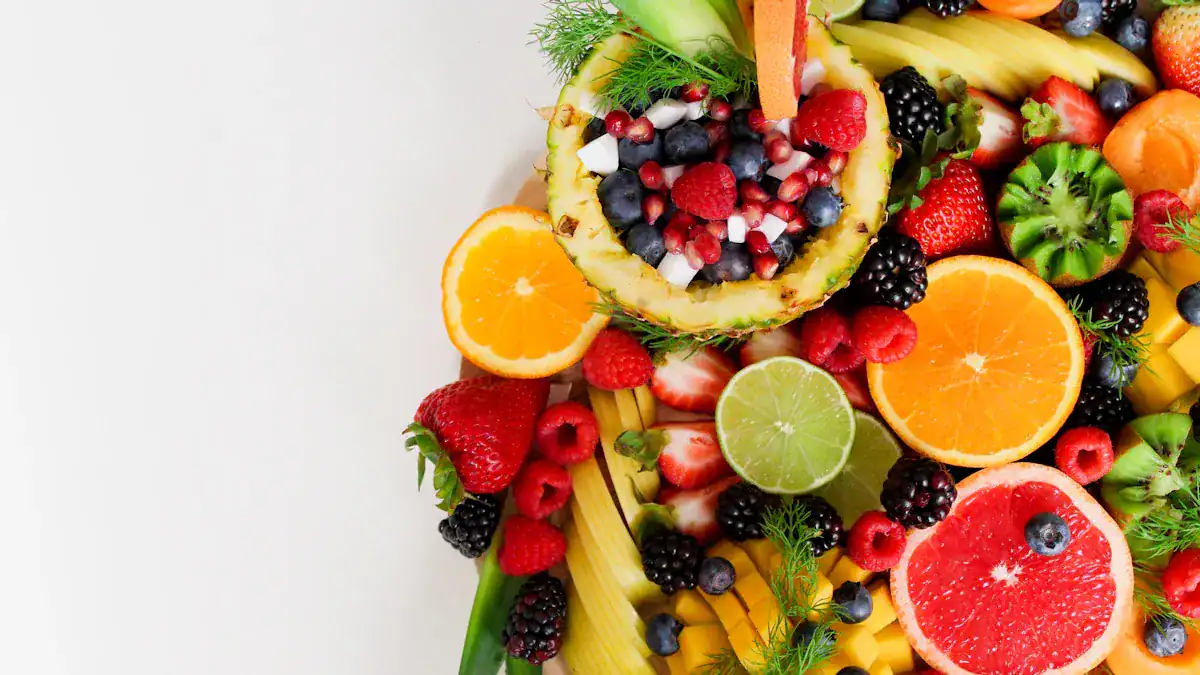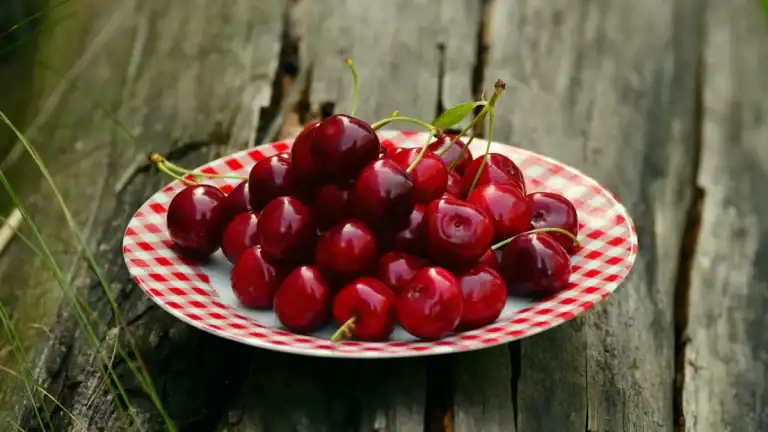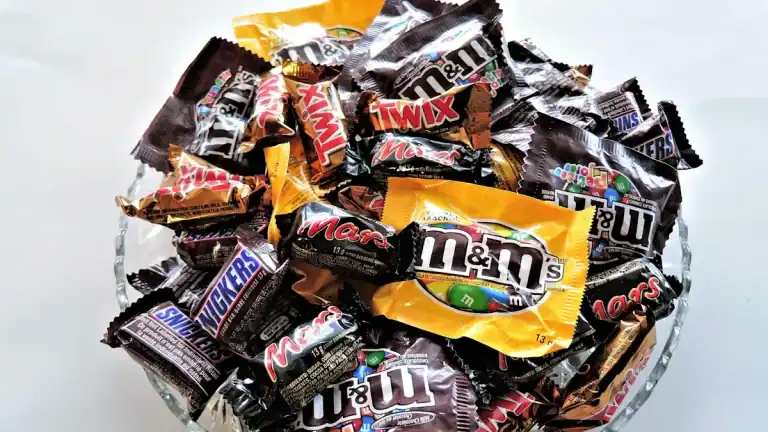
You might mistakenly think all fruit sugar is identical. You are likely interested in specific sugar types, such as fructose. This ultimate guide will clarify things for you. Knowing fructose counts is crucial for various dietary goals.
These include blood sugar management, weight control, or specific health conditions. The carbs in fruits mainly come from fructose and other sugars. The sugar content can vary significantly between fruits. This blog serves as your ultimate guide. It provides a comprehensive chart. This chart is an ultimate guide to help you make informed fruit choices. Consider this your ultimate guide to fruit sugar.
Key Takeaways
- Fruits have different amounts of sugar, especially fructose. Knowing these amounts helps you choose fruits wisely.
- Too much fructose can harm your liver and gut. This can lead to health problems like fatty liver disease.
- Whole fruits are better than fruit juice. Whole fruits have fiber, which slows down sugar absorption and keeps you full.
- The Glycemic Index (GI) and Glycemic Load (GL) show how much a food raises your blood sugar. These are important for managing blood sugar levels.
- Low-fructose fruits like avocado and berries are good choices. High-fructose fruits like mangoes and dried fruits should be eaten in smaller amounts.
Fruit Sugar Content

Carbohydrates in Fruit
You find various carbohydrates in fruits. These include monosaccharides like glucose and fructose. Fruits also contain sucrose, commonly known as table sugar. Your body’s enzymes break down sucrose into glucose and fructose for digestion.
Glucose provides the primary energy source for your brain and muscles. Fructose, while structurally similar to glucose, your liver metabolizes it. Most fruits offer excellent nutritional values. They provide negligible amounts of saturated fat, trans fat, and cholesterol. Avocados are an exception, containing about 0.5 grams of saturated fat.
Fructose: Natural Versus Added Sugar
You might wonder about the difference between natural fructose in fruit and added fructose in processed foods. Chemically, there is no distinction. Your body processes both types of sugar using identical pathways.
The key difference lies in the quantity and form you consume. Whole fruits provide fiber, vitamins, and minerals. These components mitigate potential negative effects of natural fructose. Processed foods often lack these beneficial nutrients. They deliver a high concentration of sugar without the added benefits.
Why Track Fructose
Tracking your fructose intake matters for your health. High amounts of fructose can impact your blood sugar and liver. For example, the amount of fructose in two apples or four tablespoons of honey is equivalent to the fructose in one can of soda.
High fructose consumption links to Non-Alcoholic Fatty Liver Disease (NAFLD). It also contributes to Non-Alcoholic Steatohepatitis (NASH). These conditions involve fat accumulation in your liver. This can lead to oxidative stress and insulin resistance. These issues contribute to metabolic syndrome and chronic liver disease.
Excessive fructose intake also affects your gut. It can impair gut microbiota homeostasis. This means it disrupts the balance of good bacteria in your intestines. It also reduces the intestinal barrier function. This can lead to increased gut permeability. This promotes the release of inflammatory factors. These factors contribute to inflammatory diseases.
The Ultimate Carbs In Fruit Chart
How to Read the Chart
You need to understand how to use this chart. This chart shows the fructose content for various fruits. You will see the amount of fructose per 100 grams serving. This standard measurement helps you compare different fruits easily. Knowing the sugar content helps you make smart choices about fruits and their sugar content.
Low Fructose Fruits
You can enjoy many fruits that are low in fructose. These fresh fruits are often the lowest in sugars and carbs. They are great for managing your sugar intake. Consider berries, avocado, and lemon. These fresh options offer great taste with less sugar.
Here is a table showing the fructose content for some low-fructose fruits:
| Food | Fructose (g per 100g) |
|---|---|
| Avocado | 0.2 |
| Blackberry | 3.11 |
| Strawberry | 2.3 |
| Lemon | 1.35 |
This chart visually represents the fructose in these fresh fruit options:
Avocado has very little fructose, only 0.2 grams per 100 grams. Lemon also contains a low amount, 1.35 grams. Strawberries and blackberries offer more fructose, but they are still good choices. You can see their fructose levels in the table and chart.
Moderate Fructose Fruits
Some fruits contain a moderate amount of fructose. These fruits still offer good nutrition. You can include them in your diet in controlled portions. Oranges, apples, and pears are common examples. They provide natural sugar along with fiber and vitamins.
Look at this table for their fructose content:
| Fruit | Fructose (g per 100g) |
|---|---|
| Apple | 5.9 |
| Pear | 6.2 |
| Orange | 2.4 |
This chart shows the fructose levels in these fresh fruits:
An orange has 2.4 grams of fructose per 100 grams. Apples contain 5.9 grams, and pears have 6.2 grams. You can see these numbers in the table.
High Fructose Fruits
You will find some fruits have a higher fructose content. These high sugar fruits can quickly add to your daily sugar intake. Mangoes, grapes, and dried fruits are examples. You should eat these in smaller portions. Pay attention to their sugar per 100 grams.
This table shows the fructose content for some high-fructose fruits:
| Fruit | Fructose Content |
|---|---|
| Mango | 7.7g per cup |
| Dried Sweetened Cranberries | 27g per 100g |
| Medjool Date | 7.7g per date |
| Dried Figs | 5.5g in 3 figs |
| Prunes | 3.7g in 3 prunes |
| Dried Apricots | 3.5g per oz |
Notice the high sugar content in dried fruits. Dried sweetened cranberries show 27g per 100g. A mango contains 7.7g per cup. You can see the different measurements in the table. Be mindful of these amounts.
Glycemic Index and Load of Fruits
Glycemic Index and Load Defined
You need to understand how different foods affect your blood sugar. The Glycemic Index (GI) measures how much a food’s carbohydrates can raise your blood glucose levels. This measurement compares a food to a reference, usually pure glucose. Foods fall into categories: high-GI (70 or more), moderate-GI (56-69), or low-GI (55 or less).
The Glycemic Load (GL) gives you a more complete picture. It combines the quality (GI) and quantity of carbohydrates in a food serving. You calculate GL by multiplying a food’s GI by its available carbohydrate amount in grams per serving. Then, you divide that number by 100. GL values are also categorized: high (20 or more), intermediate (11-19), or low (10 or less).
Eating high-GI foods causes a fast and high rise in your blood glucose. This signals your pancreas to release more insulin. Later, your blood glucose can drop sharply.
Low-GI foods, however, cause a slower, more steady rise in blood glucose. They put less demand on your pancreas for insulin production. For example, watermelon and a doughnut have similar GIs (around 76). However, their GLs differ greatly. Watermelon (11g carbs) has a GL of 8. A doughnut (23g carbs) has a GL of 17. This shows how carbohydrate quantity matters.
GI and GL Versus Fructose
You might wonder how GI and GL relate to fructose. Fructose is a specific type of sugar found in fruits. GI and GL measure your body’s overall blood sugar response to a food.
This response depends on all the carbohydrates in the food, not just fructose. Fiber, fat, and protein in fruits also affect how quickly your body absorbs sugars. A fruit can have a moderate amount of fructose but a low GI. This often happens because of its fiber content. Other fruits might have less fructose but a higher GI. You should consider both fructose content and GI/GL when choosing fruits.
Fruit GI and GL Examples
You can see big differences in GI among various fruits. Watermelon has a high glycemic index, typically ranging from 72-80. In contrast, many berries have low GIs. This means berries cause more stable glucose levels. This highlights a significant difference in how quickly these fruits might raise your blood sugar.
Here is a table showing the Glycemic Index for various fruits:
| Fruit | Glycemic Index (GI) |
|---|---|
| Watermelon | 75 |
| Blackberry | 25 |
| Yellow Gooseberry | 15 |
| Strawberries | 25 |
| Cranberries | 45 |
| Red Currant | 25 |
| Black Currant | 15 |
This chart visually represents the Glycemic Index of these fruits:
You can see watermelon has the highest GI among these fruits. Berries like yellow gooseberry and black currant have very low GIs. This information helps you make informed choices about which fruits to eat.
Smart Fruit Choices for Your Diet

You can incorporate fruit into your diet wisely. Consume fruit in moderation. Aim to keep your total daily fructose intake between 25 and 40 grams. For specific health goals, you might target less than 25 grams. Eating fruit as part of a meal is a good practice. This helps manage your sugar intake.
Fruit for Low-Carb Diets
You can use carbohydrate charts for fruit to identify low-sugar fruits. This helps if you follow low-carb or keto diets. Portion control remains important. Small amounts of strawberries, raspberries, and blackberries are generally acceptable. Blueberries should be consumed in small portions infrequently, or you might avoid them.
This is due to their carbohydrate content. Sweeter or larger fruits usually contain more sugar. You should avoid them on a keto diet. Berries are an exception when eaten in moderation.
Here is a table showing the carbohydrate content for some fruits:
| Fruit | Carbohydrates (g) per serving |
|---|---|
| Lemon | 0.3 (per tsp juice) |
| Olives | 5.18 (per cup green) |
| Limes | 7 (per one) |
| Tomatoes | 7.27 (per cup) |
| Avocado | 12.8 (per 150g medium) |
| Blackberries | 13.8 (per cup) |
| Raspberries | 14.6 (per cup) |
| Coconut | 12.2 (per cup) |
| Strawberries | 11.1 (per cup) |
| Watermelon | 11.7 (per cup) |
| Blueberries | 21.5 (per cup) |
This chart shows the carbohydrate content in these fruits:
You can see lemons are among the lowest in sugars and carbs. Blueberries have a higher carb count.
Fruit Portion Control
You must practice portion control with all fruits. Even healthy fruits contain natural sugars. Managing your portion sizes helps prevent high blood sugar. This is especially true if you manage diabetes. Understanding the nutritional value of each fruit helps you make informed choices.
Whole Fruit Versus Juice
You should choose whole fruit over fruit juice. Whole fruit offers significant nutritional advantages. Fruit juice may contain similar amounts of other nutrients and phytochemicals as whole fruits. However, its low fiber content and high sugar concentration are significant concerns.
Fruit juice’s sugar and energy content raises concerns about excess energy intake. This links to an increased risk of obesity and cardiometabolic diseases. Whole fruit consumption links to health benefits, partly due to its fiber content.
Consider this comparison:
| Feature | Whole Orange | Orange Juice |
|---|---|---|
| Fiber (g/serving) | 3.1 | 0.5 |
| Glycemic Load | 6.2 | 13.4 |
Whole fruits contain abundant soluble fiber. This fiber contributes to satiety. It forms a thick gel in your small intestine. This gel inhibits gastric emptying and digestive enzyme secretion. It slows down the digestion process. Consequently, the absorption of carbs, fats, and proteins occurs at a much slower rate. This prolongs your feeling of fullness and reduces hunger. This mechanism also leads to a reduction in nutrient extraction and overall energy gain.
- Lack of Fiber: Fruit juice lacks dietary fiber. This absence prevents a prolonged feeling of satiety. It potentially increases hunger and overall food intake.
- Added Sugar: Fruit juice often contains added sugar. This sugar contributes to the risk of obesity.
- Rapid Absorption: Fluids in fruit juice absorb much faster than solids. This leads to a quicker and higher spike in blood glucose and insulin levels. This rapid absorption links to an increased risk of type 2 diabetes and obesity. You should prioritize whole fruit for better health outcomes.
Our charts empower you to make healthier fruit choices. Remember, all fruits naturally contain sugars and complex sugars, but their sugar content differs. This knowledge brings many benefits. Consider your health goals when selecting these items to manage your sugar. You gain the benefit of eating fruits for a balanced diet.




